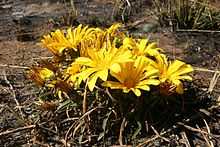Gazania krebsiana
| Gazania krebsiana | |
|---|---|
 | |
| Scientific classification | |
| Kingdom: | Plantae |
| (unranked): | Angiosperms |
| (unranked): | Eudicots |
| (unranked): | Asterids |
| Order: | Asterales |
| Family: | Asteraceae |
| Genus: | Gazania |
| Species: | G. krebsiana |
| Binomial name | |
| Gazania krebsiana Less. | |
Gazania krebsiana Less. is one of some 19 species of Gazania that are exclusively African and predominantly South African - only Gazania krebsiana subsp. serrulata (DC.) Roessler ventures northwards from the Transvaal into Tanzania.
This ground-hugging grassland species is one of the first plants to flower in spring, appearing in profusion as small clumps between low grass tussocks or burnt stubble, or as leafless single flowers seemingly stuck into the soil. Flowering lasts for only a few weeks after the first rains. The buttercup-yellow rays often occur in forms having dark spots at the base. [1] The showy flowers open only in strong sunlight, closing with fading light and re-opening the following day. This plant is perennial and grows from a woody rootstock. The leaves are tufted and linear in shape, white-felted on the underside, and exuding a milky latex when damaged.
First described by Christian Friedrich Lessing in 1832, 3 subspecies are recognised: G. krebsiana subsp. arctotoides, G. krebsiana subsp. krebsiana and G. krebsiana subsp. serrulata. The Biedouwvallei and Pakhuis Pass in the Cape present striking displays of blood-red G. krebsiana subsp. arctotoides after good autumn rains, this subspecies occurring widely through the Cape, Free State, Natal, Lesotho, and in Namibia. Gazanias have become popular garden subjects, especially in Europe because of their hardiness, and horticultural breeding has led to numerous cultivars with large flower-heads and a variety of colours. [2] Decoctions and infusions of the plant are used as analgesics (pain relief) by Bantu tribes. [3]
The genus Gazania was established by Joseph Gaertner in 1791 in his monumental work De Fructibus et Seminibus Plantarum. Two possible sources for the name are Theodore of Gaza who translated the Greek botanical works of Theophrastus into Latin, thereby laying the foundation of modern botany, and 'gaza', the Greek word for 'riches'. The specific name 'krebsiana' honours the German naturalist and apothecary, Georg Ludwig Engelhard Krebs (1792—1844), who collected natural history specimens in South Africa on behalf of the Berlin Zoological Museum. [4]
The noted taxonomist N. E. Brown observed that the genus is one of the most perplexing a botanist may deal with - the foliage within a species may be extremely variable, and the involucral bracts are extraordinarily diverse in shape and placement. Burchell came across the species a number of times between 1811 and 1814, but it seems to have reached Europe only as late as 1893 through a Mr. Max Leichtlin from Baden-Baden, and oddly in the same year through a Mr. Gumbleton, who had received seeds from a Mr. Adlam in Natal. [5]
References
- ↑ "Wild Flowers of the Transvaal" - Cythna Letty (1962)
- ↑ "Flowers of Southern Africa" - Auriol Batten (1988)
- ↑ "Medicinal and Poisonous Plants of Southern and Eastern Africa" - Watt & Breyer-Brandwijk (1962)
- ↑ "Royal Horticultural Society Dictionary of Gardening" - Fred J. Chittenden (1956)
- ↑ "Curtis's Botanical Magazine" Plate 7455 vol.122 (1896)
External links
- Dressler, S.; Schmidt, M. & Zizka, G. (2014). [http://www.africanplants.senckenberg.de/root/index.php?submitForm=true&page_id=77&searchTextMenue=Gazania+krebsiana&filterRegionIDs[]=6&filterRegionIDs[]=1&filterRegionIDs[]=2&filterRegionIDs[]=3&filterRegionIDs[]=5 "Gazania krebsiana"]. African plants – a Photo Guide. Frankfurt/Main: Forschungsinstitut Senckenberg.